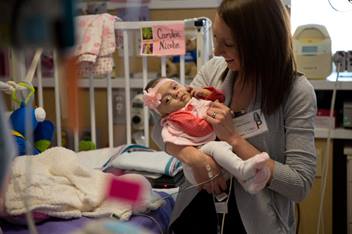Retinopathy of Prematurity (ROP)

Retinopathy of prematurity (ROP) is an eye problem in babies that are born too early (premature). You pronounce it like: re-tin-op-uh-thee of pree-mah-ture-i-tee.
What ROP Is
The retina is a layer on the inside of the back part of the eye. If the eye were a camera, the retina would be the film that takes the picture.
- The retina gets oxygen and nutrients from blood vessels in the eye (Picture 1). When babies are born early, the vessels in their eyes are still growing.

- A doctor who specializes in children’s eye care (pediatric ophthalmologist) will screen and check all babies that are less than 3 pounds and 5 ounces at birth and/or born before 31 weeks for ROP.
- About 4 to 8 weeks after a premature birth, the vessels may not be growing normally. When this happens, new vessels aren’t strong enough. They may leak fluid, bleed, or cause scarring. This is ROP.
- The smaller a baby is, the more likely they are to get ROP. Of babies that are less than 2 pounds and 3 ounces at birth, over 8 out of 10 get ROP.
- Your baby has a higher chance of getting ROP if they have:
- Are a multiple birth
How ROP Affects My Baby
ROP can range from mild to severe.
- Mild to moderate – babies see normally for their age and have no symptoms. ROP may go away when the blood vessels finish growing. These babies should not have vision loss or scarring.
- Severe ROP is a threat to your baby’s vision. It can cause total blindness. Severe ROP requires treatment.
- Because premature infants often leave the hospital before their due date, ongoing eye exams may be needed to watch ROP.
Exam
- Dilating drops will be put in your baby’s eyes to make the pupils bigger. This lets the doctor see blood vessels on the inside of the eye. Their eyes will stay dilated for 3 to 8 hours after the drops.
- An eye doctor will use 3 tools when doing your baby’s eye exam. They are used on the outside of the eyes and will not hurt your baby. Your baby will feel pressure but no pain.
- Speculum: holds their eye open.
- Depressor: directs the eye so the doctor can see into it better.
- Bright light: helps the doctor see through the lens. This may irritate your baby and make them cry. This is done quickly and will not hurt. You can shade their eyes after the exam if you want.
Treatment for Severe ROP
- Avastin®: Avastin (bevacizumab) is a medicine given as a shot. It is injected into the eye. It blocks a chemical from being made that causes the growth of abnormal blood vessels. This will give the normal vessels time to grow. This treatment is most often used for very premature babies with severe ROP. These babies can get severe ROP again and need another treatment. Your baby will be sedated for Avastin treatment.
- Laser surgery: Places many tiny laser marks on the retina inside the eye where blood vessels aren’t growing. The area of the retina without blood vessels causes the growth of the abnormal blood vessels. The laser can stop this process. Each eye takes about 30 to 45 minutes to treat. No cuts (incisions) are made to the eyes. Your baby will have general anesthesia for a laser treatment.
- After surgery, you may notice redness of the eye and puffy eyelids for 1 to 3 days. Your baby should have very little pain.
- Call right away if your baby has any of the following symptoms:
- Fever over 101° Fahrenheit (F) or 3° Celsius (C)
- Increased eye redness
- Increased pain
- Drainage from the eye
- You may need to use drops in your baby’s eyes at home for 1 to 2 weeks. These eye drops help the eye heal.
Follow-up
Follow-up appointments are very important to check on your baby’s treatment and their eye’s progress.
- When your baby goes home from the hospital, ask when their follow-up appointment is. At first, these appointments may be each day or each week. After that, if your baby is doing well, they will have fewer appointments.
- The timing of visits is important. Missing appointments can delay your baby’s treatment.
- Make sure your baby’s health care team has your current phone number and address. This helps the ophthalmologist’s office contact you about appointments and updates.
If you have questions or need to make an appointment for your child, call the Eye Clinic at (614) 722-4076.
HH-I-276 • ©1981, revised 2023 • Nationwide Children's Hospital



